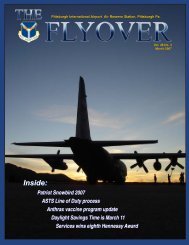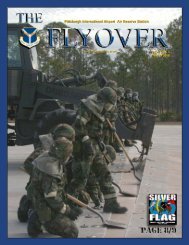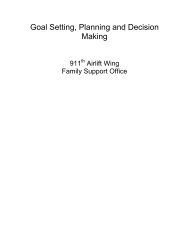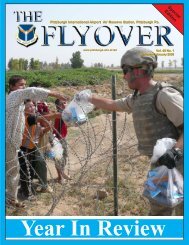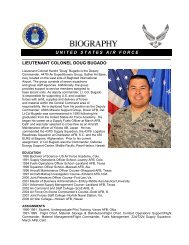February - Pittsburgh IAP Air Reserve Station
February - Pittsburgh IAP Air Reserve Station
February - Pittsburgh IAP Air Reserve Station
Create successful ePaper yourself
Turn your PDF publications into a flip-book with our unique Google optimized e-Paper software.
The Flyover<br />
<strong>Reserve</strong> component changes for Force Management<br />
The secretary of defense announced January 11, 2007<br />
a policy change in the way the department will manage<br />
reserve component forces.<br />
The first aspect of the policy change will involve the<br />
way the department manages deployments of reserve<br />
forces. Currently, reserve deployments are managed on<br />
an individual basis. In the future deployments will be<br />
managed on unit basis, allowing for greater unit cohesion<br />
and predictability for training and deployments.<br />
The second aspect of the policy change addresses<br />
the maximum mobilization time for members of the<br />
reserve forces. Currently, the policy is for a maximum<br />
mobilization time of 18 months. The department will<br />
reduce the maximum mobilization timeframe to one year.<br />
Third, the policy objective for involuntary mobilization<br />
of Guard/ <strong>Reserve</strong> units will remain a one-year mobilized<br />
to five-year demobilized ratio. However, today’s global<br />
demands will require a number of selected Guard/<br />
<strong>Reserve</strong> units to be remobilized sooner than the current<br />
policy goal. That deployment to demobilization ratio<br />
remains the goal of the department, as does the active<br />
component’s ratio goal of one year of deployment to two<br />
years at home station.<br />
News<br />
The fourth aspect<br />
of the policy change<br />
will establish a new<br />
program to<br />
compensate<br />
individuals in both<br />
active and reserve<br />
component forces<br />
that are required to<br />
mobilize or deploy<br />
earlier than<br />
established policy<br />
goals of deployment<br />
to home station ratio<br />
times. It will also<br />
involve those service<br />
<strong>February</strong> 2007<br />
Secretary of Defense<br />
Robert M. Gates<br />
5<br />
members who are required to extend beyond established<br />
rotation policy goals.<br />
The final aspect of the policy change will direct<br />
commands to review their administration of the hardship<br />
waiver program, to ensure that they have properly taken<br />
into account exceptional circumstances facing military<br />
families of deployed service members.<br />
Phishing scam baits government travel card holders<br />
Recently many 911th travel card<br />
holders have been recipients of Bank<br />
of America e-mails advising them<br />
that their Military Bank Online<br />
service accounts have or will be<br />
deactivated because of inaccurate<br />
account information.<br />
The e-mail warns that a hold is or<br />
will be placed on the account<br />
indefinitely until the account<br />
information is updated via a link in<br />
the e-mail.<br />
Bank of America has confirmed<br />
that these e-mails should be treated<br />
as fraudulent and cardholders should<br />
not respond or supply any<br />
information. There are various<br />
versions of the e-mail but the bottom<br />
line is the same - the originators of<br />
these e-mails are “phishing” for<br />
personal information.<br />
Phishing, also referred to as ‘brand<br />
spoofing’ or ‘carding,’ is a form of<br />
social engineering designed to trick<br />
customers into providing personal<br />
information to a false source.<br />
The term is a variation on “fishing,”<br />
the idea being that bait is thrown out<br />
with the hopes that someone will be<br />
tempted into biting. Phishing is the<br />
act of sending an e-mail to a user<br />
falsely claiming to be an established<br />
legitimate enterprise in an attempt to<br />
scam the user into surrendering<br />
private information that will be used<br />
for identity theft.<br />
The e-mail directs the user to visit<br />
a Website where they are asked to<br />
update personal information, such as<br />
passwords and credit card, social<br />
security, and bank account numbers,<br />
that the legitimate organization<br />
already has. The Web site, however,<br />
is bogus and set up only to steal the<br />
user’s information.<br />
• If you receive an unexpected<br />
e-mail saying your account will be<br />
shut down unless you confirm your<br />
billing information, do not reply or<br />
click any links in the e-mail body.<br />
• If you are uncertain about the<br />
information, contact the company<br />
through an address or telephone<br />
number on the back of your card.<br />
•· Report all suspicious network<br />
activity to OSI at 412-474-8824 or<br />
the communication squadron at 412-<br />
474-8444.<br />
•· Suspicious e-mail can be<br />
forwarded to uce@ftc.gov, and<br />
complaints can be filed with the state<br />
attorney general’s office or through<br />
the FTC at http://www.ftc.gov/.



